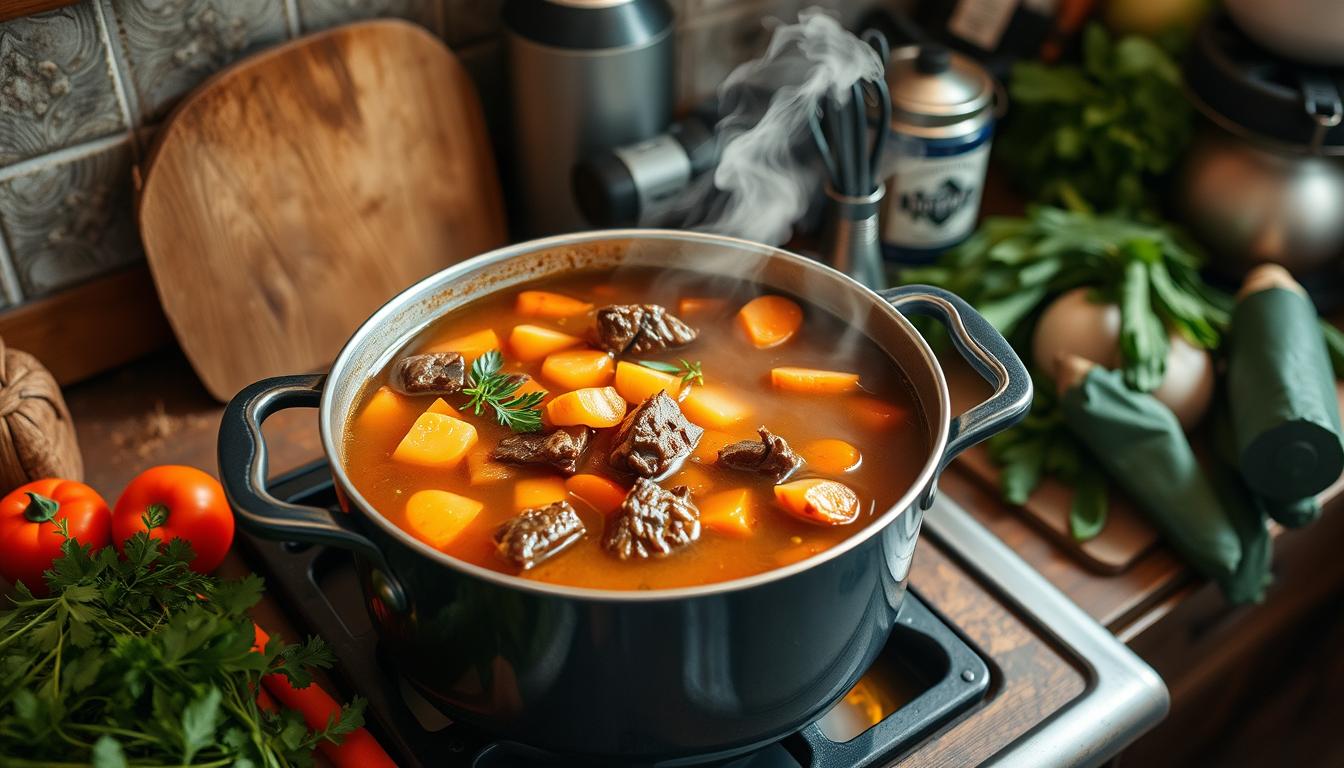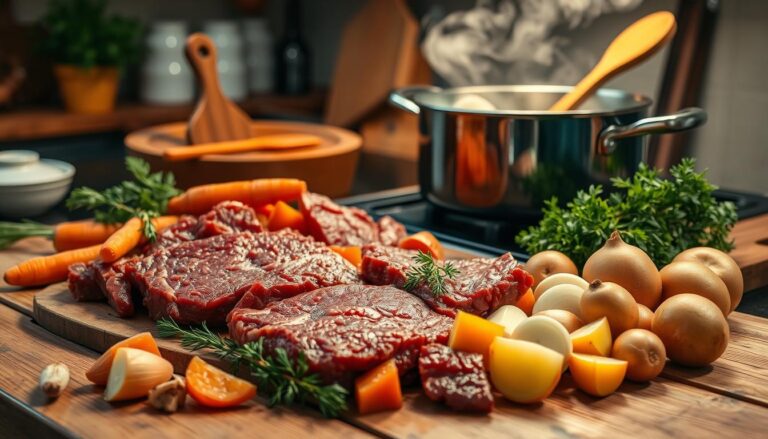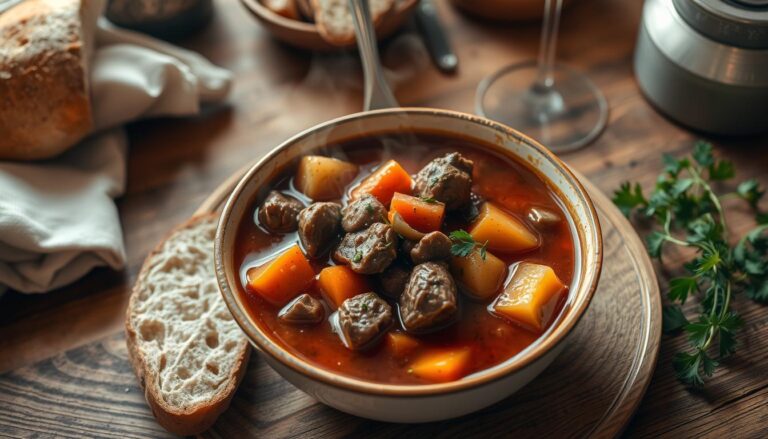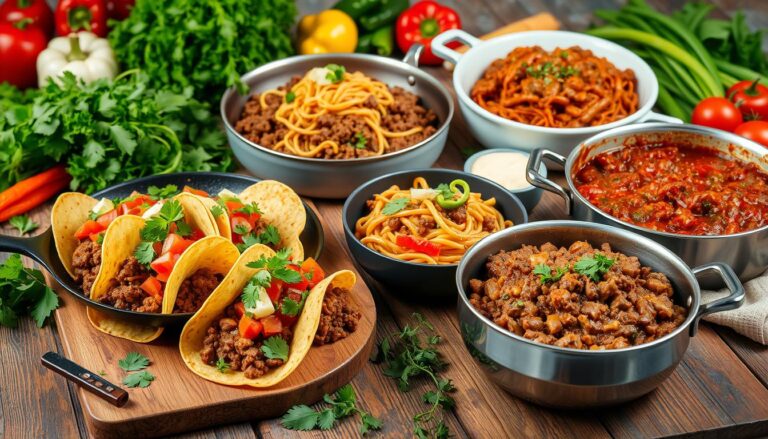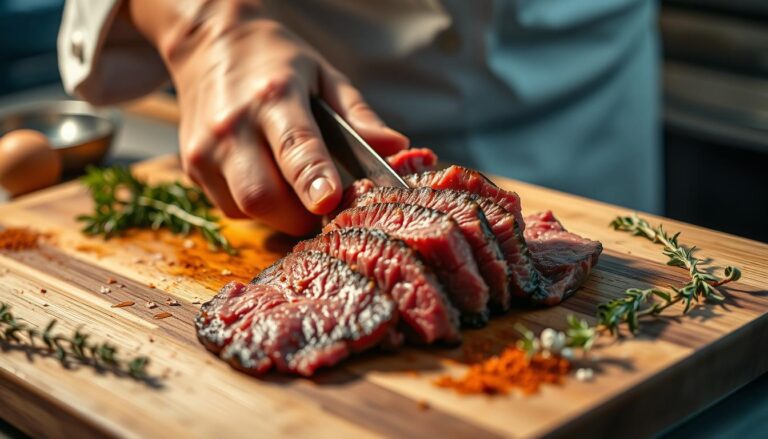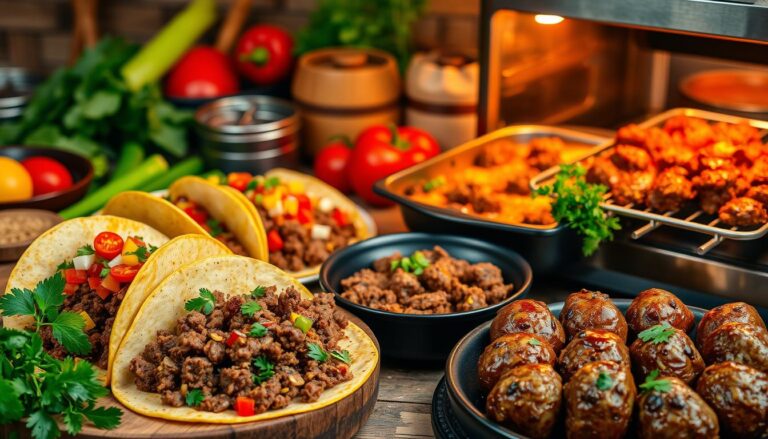Hearty Easy Beef Stew for Dinner
Winter evenings are the perfect time for a warm, comforting meal. Imagine a pot of easy beef stew filling your kitchen with a delicious smell. It’s a dish that promises to warm your heart and fill your belly.
This simple beef stew recipe is a real winner. It’s easy to make and requires just a few ingredients. With some patience, you can create a dish that’s as good as any restaurant’s.
The stew is made with tender beef, fresh veggies, and a rich broth. It’s like a big hug in a bowl. It’s the perfect meal to enjoy on a chilly evening.
Table of Contents
Introduction to Easy Beef Stew
Beef stew is the ultimate comfort food, bringing families together. It turns simple ingredients into a hearty meal that warms the heart and soul. This dish has been loved for generations, with tender meat, robust veggies, and satisfying flavors.
The Comfort Food Appeal
The best beef stew recipe connects people through comfort and nourishment. Home cooks love how it turns an ordinary evening into a special moment. The slow-cooking process blends flavors, offering a warm hug in a bowl.
- Provides emotional warmth and nostalgia
- Offers nutritious and filling meal options
- Creates lasting family memories
Historical Background of Beef Stew
Culinary historians say beef stew comes from European peasant cooking. Cooks used affordable meat and veggies to make delicious meals. These early recipes showed creativity in making tasty dishes from tough ingredients.
“A good beef stew tells a story of survival, innovation, and love.” – Unknown Chef
A classic beef stew is not just tasty but also nutritious. It has about 357 calories and 36g of protein, making it great for energy. The dish uses 3 pounds of beef chuck, browned to bring out deep flavors.
Essential Ingredients for Easy Beef Stew
Making a tasty one-pot beef stew needs the right ingredients. These ingredients should combine to make a flavorful and nutritious stew. The right mix of meats, veggies, and spices can turn a simple dish into a memorable meal.
Choosing the Right Cut of Beef
The key to a great beef stew is the meat. Beef chuck roast is the best choice because it’s tender and full of flavor. When you’re making your stew, look for these qualities:
- 2 pounds of well-marbled beef chuck
- Cut into 1-inch cubes for consistent cooking
- Avoid pre-cut “stew meat” which can be tough
Fresh Vegetables to Include
Vegetables add depth and nutrition to your stew. The best veggies to use are:
- 4 large carrots
- 1 pound baby potatoes
- 2 celery stalks
- 1 large onion
- Frozen peas for added color and sweetness
Herbs and Spices for Flavor
The right herbs and spices can make your stew amazing. Here are some flavor boosters:
| Herb/Spice | Quantity | Purpose |
|---|---|---|
| Fresh Thyme | 2 sprigs | Earthy undertone |
| Bay Leaves | 2 leaves | Deep aromatic base |
| Garlic | 3 cloves | Intense flavor |
| Black Pepper | 1/2 teaspoon | Mild heat |
“The secret to a great stew is patience and quality ingredients.” – Professional Chef
Pro tip: Adding a splash of red wine and a tablespoon of Worcestershire sauce can make your stew even more flavorful.
Preparation Methods for Easy Beef Stew
Making a tasty slow cooker beef stew is easy. You can use different cooking methods to make it a cozy meal. This works for any kitchen and schedule.
There are many ways to make a hearty beef stew. Each method has its own benefits. Let’s look at the most popular ways to get a delicious stew.
Traditional Stovetop Cooking
Stovetop cooking is a timeless way to make beef stew. It lets you control the heat and build flavors slowly. Here’s how to do it:
- Brown meat in a heavy-bottomed pot
- Sauté vegetables to enhance their natural sweetness
- Add liquid and simmer for 2-3 hours
- Stir occasionally to prevent sticking
Slow Cooker Preparation
A slow cooker beef stew is perfect for busy people. It lets the ingredients blend together with little effort.
- Brown meat before placing in the slow cooker
- Layer vegetables and seasonings
- Cook on low for 8-10 hours or high for 5-6 hours
- Enjoy tender meat and rich flavors
Instant Pot Option
The Instant Pot is great for a quick beef stew. It cooks fast without losing flavor or texture.
- Use sauté function to brown meat
- Add ingredients and seal
- Cook at high pressure for approximately 35 minutes
- Allow natural pressure release
“The secret to a great beef stew is patience and proper technique, regardless of your cooking method.” – Professional Chef
Every cooking method has its own perks. You can pick the one that suits your lifestyle and kitchen best.
Cooking Tips for Delicious Beef Stew
Making a perfect homemade beef stew needs some skill. Professional chefs have special techniques to make a quick beef stew recipe stand out.
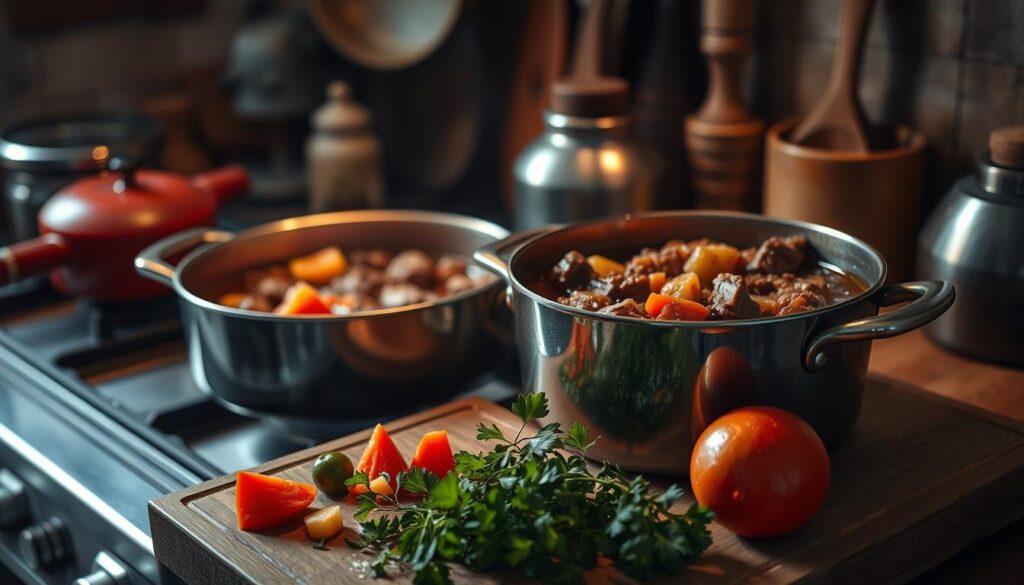
Renowned chef J. Kenji López-Alt suggests a new way to make beef stew. He says to sear big steaks before cutting them into cubes. This keeps the meat moist and adds a rich flavor.
Browning Meat for Enhanced Flavor
The secret to a great homemade beef stew is in how you prepare the meat. Here are some expert tips:
- Choose boneless chuck roast for the best taste and texture
- Sear meat in batches to avoid overcrowding
- Use high heat for a deep brown crust
- Pat meat dry before browning for perfect caramelization
“Searing larger pieces of meat releases less moisture, resulting in better browning and richer flavor” – J. Kenji López-Alt
Layering Ingredients for Best Results
Layering ingredients makes a simple quick beef stew recipe into a masterpiece. Start with onions and garlic, then add meat, followed by liquids and vegetables.
- Begin with aromatic base
- Brown meat thoroughly
- Add beef stock and wine
- Incorporate vegetables
- Simmer until tender
Pro tip: For a thicker gravy, coat beef in flour or add a cornstarch slurry near the end. Adjust seasonings as you go to get a deep, complex flavor.
Recipe Variations to Try
Turning the best beef stew recipe into a culinary adventure is exciting. Home cooks can make their hearty beef stew even better. They can try new ingredients and techniques to add depth and complexity.
Adding Wine for Depth
Adding red wine to your beef stew can really boost its flavor. Chefs suggest using strong wines like Pinot Noir or Merlot. This makes the stew rich and sophisticated.
The alcohol in the wine helps break down meat fibers. It also adds subtle flavors that make the stew more complex.
- Choose dry red wines for best results
- Add wine during the initial cooking stage
- Use approximately 1/2 cup for a standard pot
Incorporating Different Vegetables
Adding different vegetables can make your beef stew healthier and tastier. Try adding:
- Parsnips for subtle sweetness
- Mushrooms for earthy undertones
- Turnips for additional texture
Using Alternative Broths
The broth you choose is key to a great beef stew. While beef broth is traditional, trying other broths can create unique flavors.
| Broth Type | Flavor Profile | Best Paired With |
|---|---|---|
| Chicken Broth | Lighter, more delicate | Herbs like thyme |
| Vegetable Broth | Subtle, clean taste | Root vegetables |
| Beer | Rich, malty undertones | Robust meats |
“Cooking is about passion, experimentation, and creating memories around the dinner table.” – Unknown Chef
Recommended Sides for Beef Stew
Choosing the right side dishes can make a simple meal special. The perfect sides enhance the flavors of beef stew. They also add texture and variety to your meal.
Classic Bread Pairings
Bread is the best match for a hearty beef stew. Here are some tasty options:
- French Baguette: Its crispy outside and soft inside are great for soaking up stew
- Texas Roadhouse Rolls: These rolls are buttery and sweet, perfect with beef stew
- Red Lobster Cheddar Bay Biscuits: They’re cheesy and garlicky, a nice contrast to the stew
Fresh Salad Ideas
A crisp salad can balance the richness of beef stew:
- Mixed Green Salad with light vinaigrette
- Cucumber and Tomato Salad
- Arugula Salad with shaved Parmesan
Hearty Grain Options
Grains are great with beef stew, adding substance and soaking up the gravy:
- Creamy Mashed Potatoes
- Roasted Potatoes with crisp edges
- Texas Roadhouse Seasoned Rice
- Garlic Mashed Potatoes
- Roasted Root Vegetables
“A well-chosen side dish elevates a good meal to an extraordinary culinary experience.”
Try different sides to find the best match for your beef stew. This way, every meal will be satisfying and enjoyable.
Storing and Reheating Leftover Beef Stew
Keeping your classic beef stew fresh is key. You need to store and reheat it right. This way, your stew stays tasty and safe to eat for days.
Proper Storage Techniques
Storing your beef stew right is very important. It keeps the stew good and stops sickness. Here’s what to do:
- Cool the stew to room temperature within two hours of cooking
- Use airtight containers for storage
- Refrigerate at temperatures between 35°F and 38°F
- Store in the refrigerator for 3-4 days maximum
Freezing your stew? Don’t forget to leave space for it to expand. Also, skip adding potatoes, as they get mushy when thawed.
Best Methods to Reheat
Reheating your beef stew needs care to keep it tasty and tender. Here are some good ways to do it:
- Stovetop Method: Heat on medium-low, stirring occasionally
- Oven Reheating: Warm at 350°F for 30-45 minutes
- Microwave Option: Use medium power, stirring every 30 seconds
Pro Tip: Always ensure your beef stew reaches an internal temperature of 165°F (74°C) for safe consumption.
For the best taste, add a bit of beef broth when reheating. It keeps the stew moist. Don’t refreeze thawed stew to keep it at its best.
Nutritional Benefits of Beef Stew
A hearty beef stew is more than a tasty meal. It’s a nutritional powerhouse, packed with essential nutrients for health. Knowing its nutritional profile adds to its appeal, beyond its delicious taste.
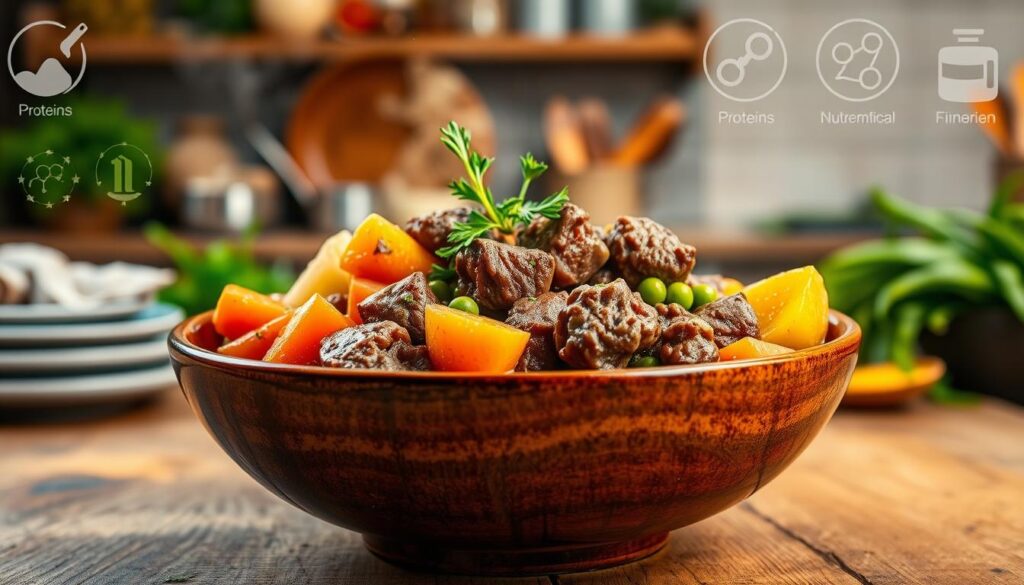
Protein Power in Every Bite
The beef in hearty beef stew is a protein powerhouse. Each 100g serving has about 20-24g of protein. This is 40-48% of the daily recommended amount. Protein is key for:
- Muscle growth and repair
- Maintaining healthy body composition
- Supporting metabolic functions
- Promoting satiety and reducing hunger
Vitamins and Minerals Breakdown
This easy dinner recipe is not just about protein. The mix of beef and veggies makes it a nutrient-dense meal. It’s rich in essential vitamins and minerals.
| Nutrient | Amount per 100g | Daily Value |
|---|---|---|
| Calories | 191 kcal | 9.5% |
| Total Fat | 10g | 15.4% |
| Iron | 2.1mg | 11.7% |
| Zinc | 4.8mg | 43.6% |
| Vitamin B12 | 2.3mcg | 96% |
“Food is not just calories, it’s information. It talks to your body at a cellular level.” – Dr. Josh Axe
Enjoying this nutritious meal? Remember to watch your portion sizes. The glycemic index of beef stew is 45. This makes it a steady energy source, without causing blood sugar spikes.
Common Mistakes to Avoid
Making the best beef stew recipe needs careful attention and knowing common mistakes. Many home cooks face errors that can ruin the quality and taste of their meal.
To make a tasty quick beef stew, avoid several common mistakes. These mistakes can affect the taste and texture of your dish.
Vegetable Cooking Challenges
Overcooking vegetables is a big mistake many cooks make in beef stew. To keep vegetables tender and flavorful, follow these tips:
- Add vegetables later in the cooking process
- Cut vegetables into uniform sizes
- Aim to add carrots and potatoes about 20 minutes before cooking ends
The Critical Browning Step
Not browning the meat is another mistake that can reduce your stew’s flavor. Experts say browning is key for rich, complex tastes.
“Browning meat before stewing is crucial for enhancing flavor through the Maillard reaction,” says Chef Dagan Lynn.
Here’s a quick guide for preparing meat in the best beef stew recipe:
| Technique | Recommendation |
|---|---|
| Meat Cut | Chuck roast, 1-inch cubes |
| Searing Temperature | 140°F |
| Searing Tip | Cook in batches to avoid overcrowding |
Other mistakes to avoid include using lean beef, rushing the cooking, and not tasting and adjusting seasoning. Remember, slow cooking is key to tender meat and developed flavors.
Conclusion: Enjoying Easy Beef Stew
An easy beef stew is more than a meal; it’s a journey that unites families. It turns simple ingredients into a comforting dish that makes memories. The homemade version lets you get creative and make it your own.
Family traditions often start in the kitchen. A well-made stew can become a treasured recipe passed down. You can try different beef cuts, vegetables, and flavors. This makes the stew a special way to bring people together.
Making it Part of Family Traditions
Starting a family tradition with homemade beef stew is more than following a recipe. It’s about sharing cooking tips, learning from each other, and enjoying making the meal together. Every step, from picking the beef to slow-cooking, is a chance to connect and share.
Encouraging Creativity in Recipes
Beef stew is all about creativity. You can swap ingredients, mix new spices, or try different cooking ways like Instant Pot or slow cooker. A great stew shows off the cook’s personality and creativity, making every meal an adventure.

